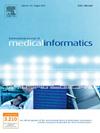利用深度迁移学习增强医学影像中的白血病检测
IF 4.1
2区 医学
Q2 COMPUTER SCIENCE, INFORMATION SYSTEMS
International Journal of Medical Informatics
Pub Date : 2025-06-26
DOI:10.1016/j.ijmedinf.2025.106023
引用次数: 0
摘要
急性淋巴细胞白血病(acute Lymphoblastic Leukemia, ALL)是最常见的儿科癌症,需要早期发现以挽救生命并减轻晚期治疗的经济负担。传统的诊断方法耗时且资源密集,而深度迁移学习为医学图像分类提供了一种计算效率高的替代方法。方法采用VGG-19和EfficientNet-B3两种被广泛认可的迁移学习算法,使用来自118名患者的10,661张公开数据集检测ALL。数据预处理包括调整大小、增大和规范化。模型训练了100个epoch, VGG-19的批大小为30,effentnet - b3的批大小为32。评估指标如准确性、精密度、召回率和F1分数被用来评估模型的性能。采用配对t检验(p <;0.05)。并与已有研究进行对比分析,验证研究结果。结果fficientnet - b3显著优于VGG-19,平均准确率为96%,而VGG-19为80% (p <;0.001)。EfficientNet-B3在处理类不平衡方面表现优异,少数类(Hem)的准确率、召回率和F1得分分别达到97%、89%和93%。VGG-19在少数班级中挣扎,取得了较低的回忆(51%)和F1分数(62%)。然而,包括单一来源的数据集限制可能会影响推广。结论本研究突出了effentnet - b3作为早期ALL检测的可靠工具的有效性,具有较高的准确性和计算效率。临床实施需要解决计算限制和集成挑战。未来的研究可以整合多模态数据集来识别危险因素,进一步提高诊断的准确性。本文章由计算机程序翻译,如有差异,请以英文原文为准。
Enhancing leukemia detection in medical imaging using deep transfer learning
Background
Acute Lymphoblastic Leukemia (ALL) is the most common pediatric cancer, requiring early detection to save lives and reduce the financial burden of advanced-stage treatment. While traditional diagnostic methods are time-consuming and resource-intensive, deep transfer learning offers a computationally efficient alternative for medical image classification.
Method
This study employed two widely recognized transfer learning algorithms, VGG-19 and EfficientNet-B3, to detect ALL using a publicly available dataset of 10,661 images from 118 patients. Data preprocessing included resizing, augmentation, and normalization. The models were trained for 100 epochs, with batch sizes of 30 for VGG-19 and 32 for EfficientNet-B3. Evaluation metrics such as accuracy, precision, recall, and F1 score were used to assess model performance. Statistical significance testing was performed using paired t-tests (p < 0.05). Comparative analysis was performed with existing studies to validate the findings.
Results
EfficientNet-B3 significantly outperformed VGG-19, achieving an average accuracy of 96 % compared to 80 % for VGG-19 (p < 0.001). EfficientNet-B3 demonstrated superior performance in handling class imbalance, with the minority class (Hem) achieving precision, recall, and F1 scores of 97 %, 89 %, and 93 %, respectively. VGG-19 struggled with the minority class, achieving lower recall (51 %) and F1 score (62 %). However, dataset limitations including single-source origin may affect generalizability.
Conclusion
This study highlights the effectiveness of EfficientNet-B3 as a reliable tool for early ALL detection, offering high accuracy and computational efficiency. Clinical implementation requires addressing computational constraints and integration challenges. Future research could integrate multimodal datasets to identify risk factors and further improve diagnostic accuracy.
求助全文
通过发布文献求助,成功后即可免费获取论文全文。
去求助
来源期刊

International Journal of Medical Informatics
医学-计算机:信息系统
CiteScore
8.90
自引率
4.10%
发文量
217
审稿时长
42 days
期刊介绍:
International Journal of Medical Informatics provides an international medium for dissemination of original results and interpretative reviews concerning the field of medical informatics. The Journal emphasizes the evaluation of systems in healthcare settings.
The scope of journal covers:
Information systems, including national or international registration systems, hospital information systems, departmental and/or physician''s office systems, document handling systems, electronic medical record systems, standardization, systems integration etc.;
Computer-aided medical decision support systems using heuristic, algorithmic and/or statistical methods as exemplified in decision theory, protocol development, artificial intelligence, etc.
Educational computer based programs pertaining to medical informatics or medicine in general;
Organizational, economic, social, clinical impact, ethical and cost-benefit aspects of IT applications in health care.
 求助内容:
求助内容: 应助结果提醒方式:
应助结果提醒方式:


